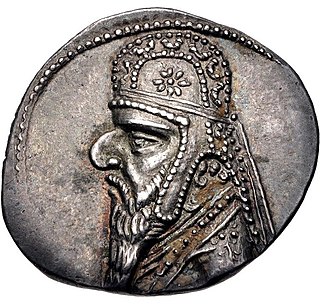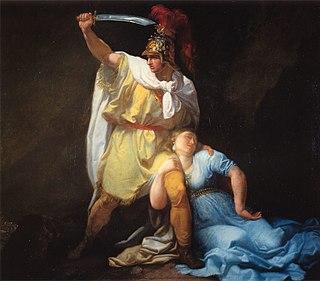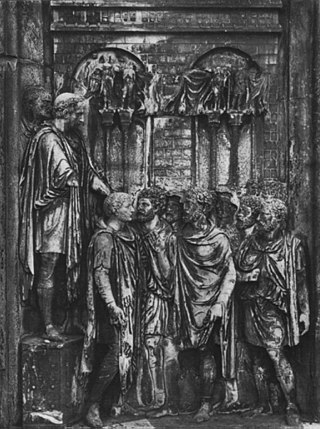Related Research Articles

Mithridates II was king of the Parthian Empire from 124 to 91 BC. Considered one of the greatest of his dynasty to ever rule, he was known as Mithridates the Great in antiquity.

Vologases I was the King of Kings of the Parthian Empire from 51 to 78. He was the son and successor of Vonones II. He was succeeded by his younger son Pacorus II, who continued his policies.

Phraates IV was King of Kings of the Parthian Empire from 37 to 2 BC. He was the son and successor of Orodes II, and was given the throne after the death of his brother Pacorus I. Phraates IV soon murdered all his brothers, and also possibly his father. His actions alienated the Armenians and also some of his nobles, including the distinguished Monaeses, who fled to the Roman triumvir Mark Antony, but shortly returned and reconciled with Phraates IV.

Orodes II, was King of Kings of the Parthian Empire from 57 BC to 37 BC. He was a son of Phraates III, whom he murdered in 57 BC, assisted by his elder brother Mithridates IV. The two brothers quickly fell out and entered into a dynastic struggle, in which Orodes was triumphant.

Artabanus II, incorrectly known in older scholarship as Artabanus III, was King of Kings of the Parthian Empire from 12 to 38/41 AD, with a one-year interruption. He was the nephew and successor of Vonones I. His father has been variously identified as a Dahae or Atropatid prince, whilst his mother was a daughter of the Parthian King of Kings Phraates IV.

Vonones I was an Arsacid prince, who ruled as King of Kings of Parthian Empire from 8 to 12, and subsequently as king of Armenia from 12 to 18. He was the eldest son of Phraates IV and was sent to Rome as a hostage in 10/9 BC in order to prevent conflict over the succession of Phraates IV's youngest son, Phraataces.

Gotarzes II was king of the Parthian Empire from 40 to 51. He was an adopted son of Artabanus II. When his father died in 40, his brother Vardanes I was to succeed to the throne. However, the throne was seized by Gotarzes II. Gotarzes II eventually was able to gain control of most of Parthia forcing Vardanes to flee to Bactria. With the death of Vardanes in c. 46, Gotarzes II ruled the Parthian Empire until his death. Gotarzes II was succeeded by his uncle Vonones II.

Rhadamistus was a royal prince of the Pharnavazid dynasty of the Kingdom of Iberia who reigned over the Kingdom of Armenia from 51 to 53 and 54 to 55. He was considered a usurper and tyrant, who was overthrown in a rebellion supported by the Parthian Empire.

Relations between the Roman and Iranian states were established c. 92 BC. It was in 69 BC that the two states clashed for the first time; the political rivalry between the two empires would dominate much of Western Asia and Europe until 628. Initially commencing as a rivalry between the Parthians and Rome, from the 3rd to mid-7th centuries the Roman Empire and its rival Sassanid Persia were recognized as two of the leading powers in the world.
The Arsacid dynasty, called the Arshakuni in Armenian, ruled the Kingdom of Armenia from 12 to 428 AD. The dynasty was a branch of the Arsacid dynasty of Parthia. Arsacid kings reigned intermittently throughout the chaotic years following the fall of the Artaxiad dynasty until 62, when Tiridates I, brother of Parthian King Vologases I, secured Arsacid rule in Armenia as a client king of Rome. However, he did not succeed in establishing his line on the throne, and various princes of different Arsacid lineages ruled until the accession of Vologases II, who succeeded in establishing his own line on the Armenian throne, which ruled the kingdom until its abolishment by the Sasanian Empire in 428.

Tiridates I was King of Armenia beginning in 53 AD and the founder of the Arsacid dynasty of Armenia. The dates of his birth and death are unknown. His early reign was marked by a brief interruption towards the end of the year 54 and a much longer one from 58 to 63. In an agreement to resolve the Roman–Parthian conflict in and over Armenia, Tiridates I was crowned king of Armenia by the Roman emperor Nero in 66; in the future, the king of Armenia was to be a Parthian prince, but his appointment required approval from the Romans. Even though this made Armenia a client kingdom, various contemporary Roman sources thought that Nero had de facto ceded Armenia to the Parthian Empire.
Mithridates of Armenia was a Pharnavazid prince of the Kingdom of Iberia who served as a King of Armenia under the protection of the Roman Empire.

The Parthian Empire, also known as the Arsacid Empire, was a major Iranian political and cultural power centered in ancient Iran from 247 BC to 224 AD. Its latter name comes from its founder, Arsaces I, who led the Parni tribe in conquering the region of Parthia in Iran's northeast, then a satrapy (province) under Andragoras, who was rebelling against the Seleucid Empire. Mithridates I greatly expanded the empire by seizing Media and Mesopotamia from the Seleucids. At its height, the Parthian Empire stretched from the northern reaches of the Euphrates, in what is now central-eastern Turkey, to present-day Afghanistan and western Pakistan. The empire, located on the Silk Road trade route between the Roman Empire in the Mediterranean Basin and the Han dynasty of China, became a center of trade and commerce.

Pharasmanes I the Great was a king (mepe) of Caucasian Iberia. He plays a prominent role in the historian Tacitus' account of policy and campaigns in the eastern lands of the Roman Empire under Tiberius, Caligula, Claudius and Nero. According to Cyril Toumanoff, Pharasmanes was a member of the third Pharnavazid dynasty and reigned from 1 to 58. Pharasmanes is mentioned on the Stele of Vespasian. During his reign, Iberia was transformed into the Transcaucasian empire, that would dominate the kingdoms of Armenia and Albania.

The war between the kingdoms of Iberia and Armenia is known chiefly through its description in Tacitus 'Annals.

Arsaces I of Armenia, also known as Arsaces I, Arshak I and Arsak was a Parthian prince who was king of Armenia during 35 AD.

A client kingdom or people in ancient Rome meant a kingdom or ancient people that was in the condition of "appearing" still independent, but in the "sphere of influence" and thus dependence of the neighboring Roman Empire. It was a form of modern protectorate, where the kingdom or territory in question was controlled (protected) by a stronger one (protector).
References
- ↑ Chaumont, Armenia between Rome and Iran I: the advent of Augustus to the accession of Diocletian, p.89
- ↑ Tacitus, Annals, 6.33
- ↑ Grousset, History of Armenia from its origins to 1071, p.105
- ↑ Chaumont, Armenia between Rome and Iran I: the advent of Augustus to the accession of Diocletian, p.89
- ↑ Grousset, History of Armenia from its origins to 1071, p.106
- ↑ Tacitus, Annals, 6.33-35
- ↑ Chaumont, Armenia between Rome and Iran I: the advent of Augustus to the accession of Diocletian, p.90